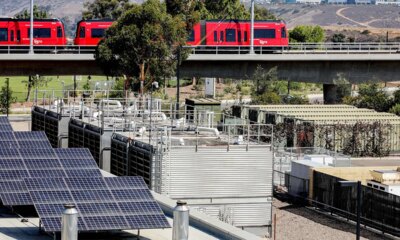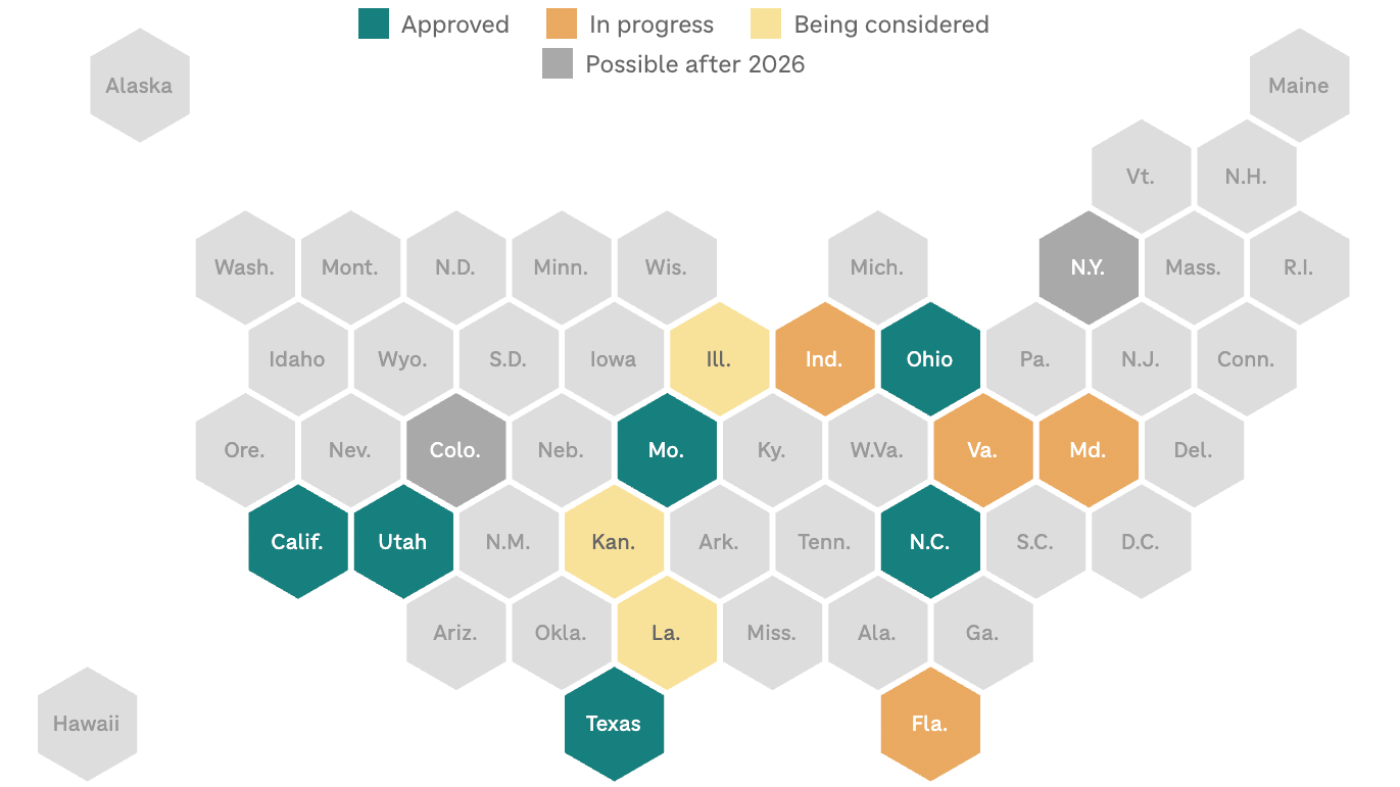California
Here's what happened to California election results while you were sleeping

In summary
Against a national red wave, Californians sent a top Trump nemesis to the US Senate, and favored Democrats in House and state races. But they also toughened criminal sentences and rejected more rent control.
While Republicans celebrated a red wave nationally, California voters affirmed the state’s solid blue politics with Democratic candidates seeing strong returns for state and federal office.
As the prospect of a second Donald Trump presidency loomed large over California, the state elected a new U.S. senator in Adam Schiff. A Burbank Democrat, Schiff made a national name for himself in the U.S. House by leading the prosecution of Trump’s first impeachment and for his key role investigating the Jan. 6th storming of the Capitol.
Democrats were also leading the most contested races to represent California in Congress, and they were leading in races that would expand their supermajority in the state Legislature, making the state well positioned to lead the resistance to a second Trump presidency.
But California’s voters were hesitant to fully embracing a progressive agenda. They soundly passed a ballot initiative to raise criminal sentences, a measure Gov. Gavin Newsom and the progressive wing of the Legislature had opposed. They once again rejected a ballot initiative that would have permitted an expansion of rent control.
And they also ousted a progressive prosecutor in Los Angeles County, the state’s largest.
“It’s just one of these things where the allegiance to Democratic candidates and supporting Democratic candidates doesn’t always mean an allegiance to every progressive cause,” said Paul Mitchell, an election analyst.
News outlets called Democrat Kamala Harris the winner of the state’s electoral votes the moment polls closed at 8 p.m., and also swiftly called the race to claim the U.S. Senate seat long held by Democrat Dianne Feinstein. Schiff cruised to victory against Steve Garvey, a former L.A. Dodgers star seeking to become the first Republican elected statewide in 18 years. Schiff won a six-year term to replace Sen. Laphonza Butler, who decided not to run for reelection after she was appointed by Newsom to replace Feinstein, who died last year.
Democrats took early leads in four of six contested Congressional races, key seats that could keep Democrats in control of that chamber and act as a bulwark against Trump.
The Associated Press still hasn’t called who controls the House of Representatives , and it could take days or more to determine the victors in several of those contested races, particularly in California.
On ballot measures, voters overwhelmingly passed Proposition 36, which progressives opposed, that increases sentences for certain crimes and partial vote totals show them rejecting progressive-sponsored Prop. 6 that would prohibit forced labor in prisons. Prop. 33, which would expand rent control, failed.
Prop. 32, which would raise the minimum wage, was too close to call, as were several other statewide propositions.
Meanwhile, Democrats were leading their Republican opponents in three contested Legislative seats, which would expand the supermajority they need to raise taxes or put initiatives on the ballot without a single Republican vote.
But should early vote totals hold, Mike Gatto, a former Democratic state lawmaker from Los Angeles, cautioned members of his party not to consider it an edict from the California electorate to embrace far-left policies in response to Trump’s return to office.
Gatto noted that California’s voters appear to have signaled through the state’s ballot initiatives a more moderate platform. Taken with the national election results, Gatto said California’s elected Democrats should be mindful of appearing too liberal.
“I think it would be wise for California Democrats to try to moderate the agenda a little bit,” Gatto said.
In Los Angeles County, voters chose Nathan Hochman — a former federal prosecutor who ran for state Attorney General as a Republican in 2022 — to replace incumbent District Attorney George Gascón, a progressive.
Some experts say the votes show California has more nuanced political views than its national reputation as a liberal bastion suggests.
Christian Grose, professor of political science at University of Southern California, saw the mixed bag as fairly typical for California.
“The state in general seems like it’s still going Democratic, and might swing the U.S. House to the Democrats,” he said, “while also supporting policies sometimes that are a little bit more conservative and a little bit more liberal.”
One note of caution about overnight California election results: For some of the closest races, it may be weeks before we know the final outcome. Though this has stoked mistrust among voters, the reasons are not nefarious.
Since 2020, California has mailed a ballot to every registered voter — a convenience that requires additional verification by local elections officials when it’s returned, including authenticating the signature and checking that the voter has not already cast a ballot in another jurisdiction before counting it. The counting takes significantly more manual labor, as workers must open the envelopes, extract the ballots, align them for counting machines and duplicate any damaged ballots that cannot be read.
California accepts ballots that arrive up to seven days late, as long as they are postmarked by election day, and give voters an opportunity to fix missing or mismatched signatures. These delays are deliberate, to minimize the number of legitimate voters disqualified for procedural reasons and ensure a secure and accurate count.
CalMatters Capitol reporter Alexei Koseff contributed to this story.
Source link

California
Comic shop burglary in Southern California puts cat rescue at risk

Cats & Comics Rescue, a downtown Upland shop that relies on the sale of comic books and collectibles to support the care of dozens of rescue cats, is recovering from a break-in that occurred early Friday morning. Surveillance footage shows a suspect shattering the front entrance around 5 a.m. and heading directly for the store’s display cases, taking rare comic books, Pokémon cards and other items before fleeing.
Jeremy Guerra, the shop’s owner, said the financial loss is substantial. While the full scope of the theft is still being assessed, he estimated that the value of stolen comics alone exceeds $5,000. The impact, he said, extends beyond merchandise. The sales of those items help fund the rescue operation located within the same space, covering medical care, food and other essentials for cats awaiting adoption. The shop is currently caring for 22 cats.
“The reason why we do cats and comics is because the cat rescue doesn’t survive alone,” Guerra said. “This is the big part, it’s the comics and card sales, that’s what keeps us alive.”
The shop allows visitors to spend time with the animals for a $5 fee, and all cats are available for adoption at an additional cost that includes vaccinations, spay or neuter services and deworming. The space doubles as a comic store and an animal sanctuary, offering a space where customers can both browse and connect with the cats waiting to be adopted.
After news of the break-in spread, community members began offering support. A mother and daughter arrived with donations of cat food and cash, contributions Guerra described as deeply moving. “When people bring in donations, it does get me teary-eyed, for sure,” he said.
Despite the setback, Guerra said the community’s response has affirmed the shop’s mission. Those who wish to contribute can donate online or provide items such as cat food.
Cats & Comics Rescue remains open daily at 136 E. 9th St. from 10 a.m. to 9 p.m. Information about supporting the rescue or adopting a cat is available through the shop’s official website.
Jillian Smukler’s reporting contributed to this article.
California
Warning against mushroom foraging in California after fatal poisoning

Officials in California are urging people not to forage for wild mushrooms after a rise in poisoning cases caused at least one death.
The California Poison Control System has identified 21 cases of amatoxin poisoning clustered in northern California, likely resulting from death cap mushrooms, the state’s department of public health said.
The poisoning resulted in severe liver damage in several people, including children, and at least one of the patients may need a liver transplant, the department said.
Death cap mushrooms can easily be mistaken for safe, edible mushrooms because of their similar taste, smell, and appearance.
The confirmed cases happened between mid-November and early December, a rainy season in the region that creates ideal conditions for the deadly variety to grow, mostly near oaks and hardwood trees like pine trees, the California Department of Public Health (CDPH) said.
Though the cases are mostly in the Monterey and San Francisco Bay area of Northern California, the risk is statewide, the department warned.
“Death cap mushrooms contain potentially deadly toxins that can lead to liver failure,” Dr Erica Pan, CDPH Director and State Public Health Officer, said in a statement. “Because the death cap can easily be mistaken for edible safe mushrooms, we advise the public not to forage for wild mushrooms at all during this high-risk season.”
The death cap mushroom is never safe to eat, even if it is boiled, dried, frozen or cooked.
Eating the deadly mushrooms can cause watery diarrhoea, nausea, vomiting, abdominal pain and dehydration within six to 24 hours – and although symptoms may initially wane, severe or fatal liver damage can still occur up to eight days later.
“Only people with extensive training and experience should eat wild mushrooms that they have picked themselves,” Dr Edward Moreno, County of Monterey Health Officer, said in a statement.
California
1 killed, more than 20 poisoned by death cap mushrooms in California, officials say

SAN FRANCISCO — California officials are warning foragers after an outbreak of poisoning linked to wild mushrooms that has killed one adult and caused severe liver damage in several patients, including children.
The state poison control system has identified 21 cases of amatoxin poisoning, likely caused by death cap mushrooms, the health department said Friday. The toxic wild mushrooms are often mistaken for edible ones because of their appearance and taste.
“Death cap mushrooms contain potentially deadly toxins that can lead to liver failure,” Erica Pan, director of the California Department of Public Health, said in a statement. “Because the death cap can easily be mistaken for edible safe mushrooms, we advise the public not to forage for wild mushrooms at all during this high-risk season.”
One adult has died and several patients have required intensive care, including at least one who might need a liver transplant.
Officials advise against wild mushroom foraging
Wet weather fuels the growth of death cap mushrooms, and officials warn against any wild mushroom foraging to avoid confusion. Residents in central California’s Monterey County became ill after eating mushrooms found in a local park, according to county health officials. Another cluster of cases were in the San Francisco Bay Area, but state health officials warned that the risk is everywhere.
There were more than 4,500 cases of exposure to unidentified mushrooms logged at America’s Poison Centers in 2023, according to their National Poison Data System annual report. Roughly half were in young children, who experts warn may pick and eat a mushroom while playing outside.
California’s poison control system sees hundreds of cases of wild mushroom poisonings each year. The death cap mushroom and the “destroying angel” mushroom look and taste similar to edible mushrooms, so experts warn that a mushroom’s color is not a reliable way of detecting its toxicity. And whether it is eaten raw or cooked does not matter.
Symptom improvement is not an all-clear
People can have stomach cramping, nausea, diarrhea or vomiting within 24 hours after ingesting a toxic mushroom. Though gastrointestinal symptoms may improve, health officials warn that patients can still develop serious complications, including liver damage, that surface later.
People looking for guidance on diagnosing or treating mushroom poisoning can contact the poison control hotline at 1-800-222-1222.
Copyright © 2025 by The Associated Press. All Rights Reserved.
-

 Alaska2 days ago
Alaska2 days agoHowling Mat-Su winds leave thousands without power
-

 Politics6 days ago
Politics6 days agoTrump rips Somali community as federal agents reportedly eye Minnesota enforcement sweep
-
Ohio4 days ago
Who do the Ohio State Buckeyes hire as the next offensive coordinator?
-

 News6 days ago
News6 days agoTrump threatens strikes on any country he claims makes drugs for US
-

 World6 days ago
World6 days agoHonduras election council member accuses colleague of ‘intimidation’
-

 Texas2 days ago
Texas2 days agoTexas Tech football vs BYU live updates, start time, TV channel for Big 12 title
-

 Politics6 days ago
Politics6 days agoTrump highlights comments by ‘Obama sycophant’ Eric Holder, continues pressing Senate GOP to nix filibuster
-

 Politics1 week ago
Politics1 week agoWar Sec Pete Hegseth shares meme of children’s book character firing on narco terrorist drug boat





































